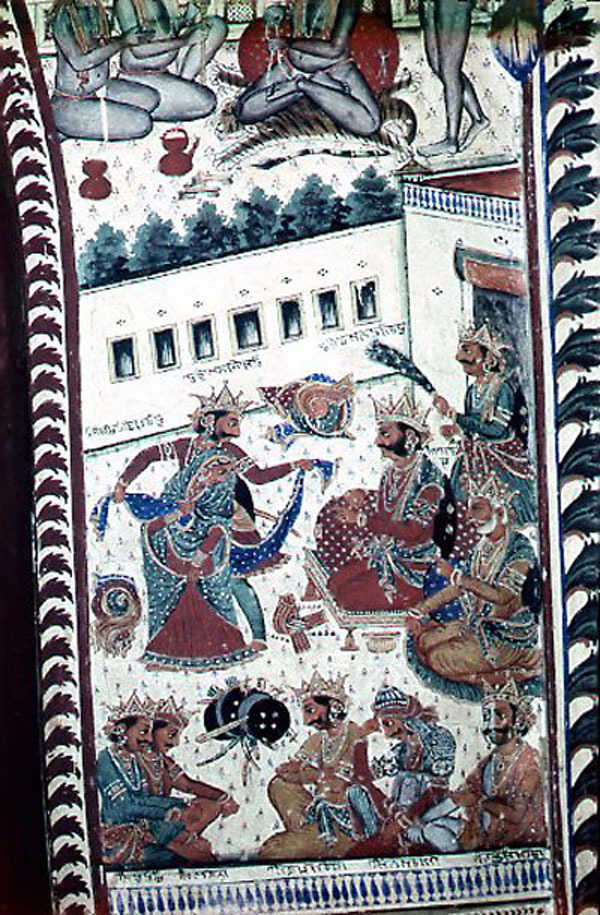Akhara murals gasp for a breath of air
Kanwarjit Singh Kang
The art of mural painting became a popular mode of embellishment in the first quarter of the 19th century; and Amritsar, historically known as Ramdaspur, formed the nucleus of this activity. Almost every structure in this historical town was embellished with murals. Besides Sikh shrines like the Golden Temple, Akal Takht and Baba Atal, the local akharas, monasteries belonging to the Udasi and Nirmala sects, vied with each other to get these painted with murals.
Founded in 1775 A.D, Akhara Mahant Bala Nand is one of the akharas located in Amritsar, where Udasis, an ascetical sect founded by Sri Chand, elder son of Guru Nanak, propagated the concept of righteousness. This akhara appears imposing due to its triple-storied structure built in solid masonry by Mahant Bhishambar Prashad in 1888 A.D. When I visited this akhara in 1971, almost all portions of its walls were embellished with paintings. Most of these, however, have faded with time.
The most prominent and large-sized mural panel in the akhara illustrated the 10 Sikh Gurus. Guru Nanak Dev was sitting in the centre under a tree, in his characteristic meditative pose with a rosary in his right hand and his back supported by a round bolster. Other Gurus were portrayed sitting on both sides of Guru Nanak. Bhai Bala and Bhai Mardana, former a chauri-bearer and the later a rebeck player to the Guru, were also delineated in this mural.
Another mural depicting Guru Nanak Dev was on the theme of Sidh-Gosti i.e. discourse or dialogue with siddhas or the mystics in which questions are raised by the siddhas and all answers come from Guru Nanak. As usual, Guru Nanak was sitting under a tree on which birds were shown perching and he was flanked by siddhas whose names, like Machhindarnath and Charpatnath, were written in Gurmukhi above their heads, apparently for instant identification.
A mural depicted Lord Vishnu in his second incarnation of Kurma or tortoise — the avatar he took during the churning of ocean by the gods and the demons to obtain the elixir of immortality. In another mural, he was shown in his fourth incarnation, assuming the form of Narasimha or man-lion about to save Prahlada from Hiranyaksipu.
One more painted panel depicted Vishnu reclining on the cosmic serpent Shesha floating on the eternal waters. From his navel sprouted a lotus with Brahma emerging on its petals. Shiv and Parvati, in the act of preparing intoxicating potion, were also illustrated in one of the murals.
Themes from the Ramayana and the Mahabharata were also painted in the akhara. In one lengthy panel was depicted the scene of Rama ascending the throne of Ayodhya after the end of his period of exile. A mural illustrated the disrobing of Draupadi by the Kaurvas and five Pandava brothers sitting (with their heads hanging in shame) in depression.
There were also several panels related to bhagats like Namdev, Ravidas, Kabir, Dhanna, Sain and Narsi. Baba Sri Chand was portrayed as engaged in religious discourse with his followers. On three painted panels appeared Udasi saints absorbed in seminaries of religious learning, with the principal preacher sitting in the centre. Some of them have been shown performing their prayers with the ringing of bells and blowing narsingha, a trumpet-like musical instrument. A panel of group portraits depicted the mahants of the akhara and major personages have been identified by their names written in Gurumuki over their heads.
One could also find one of the best murals on Sikh royalty. It portrayed Maharaja Ranjit Singh with his sons, Kharak Singh, Sher Singh and Nau Nihal Singh. The Maharaja sat on a green oval rug facing his sons. Raja Dhian Singh stood behind the Maharaja. His three sons sat on a brown oval rug; Kharak Singh with folded hands in the front; Sher Singh holding a gun and a sword in the centre and Nau Nihal Singh, again with folded hands, in the rear. Two guards, one on each side, with costumes having braided piping and polished brass buttons, matched the regalia of the Sikh court. This composition is set in a marbled terrace or baradari. An adjoining mural depicted Hari Singh Nalwa inspecting a long row of Sikh soldiers.
It is unfortunate that most of these murals have faded now and efforts have not been made to preserve such a vast repertoire of art.









